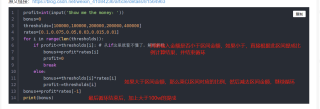Python的基础运用
题目 企业发放的奖金根据利润提成。
利润(I)低于或等于10万元时,奖金可提10%;
利润高于10万元,低于20万元时,低于10万元的部分按10%提成,高于10万元的部分,可提成7.5%;
20万到40万之间时,高于20万元的部分,可提成5%;40万到60万之间时高于40万元的部分,可提成3%;
60万到100万之间时,高于60万元的部分,可提成1.5%; 高于100万元时,超过100万元的部分按1%提成;
从键盘输入当月利润I,求应发放奖金总数?
-——
版权声明:本文为CSDN博主「超级大黄狗Shawn」的原创文章,遵循CC 4.0 BY-SA版权协议,转载请附上原文出处链接及本声明。
原文链接:https://blog.csdn.net/weixin_41084236/article/details/81564963
profit=int(input('Show me the money: '))
bonus=0
thresholds=[100000,100000,200000,200000,400000]
rates=[0.1,0.075,0.05,0.03,0.015,0.01]
for i in range(len(thresholds)):
if profit<=thresholds[i]: # 从if这里就看不懂了,解释解释
bonus+=profit*rates[i]
profit=0
break
else:
bonus+=thresholds[i]*rates[i]
profit-=thresholds[i]
bonus+=profit*rates[-1]
print(bonus)

- 我从CSDN技能树中找了一些相关资料给你, 你可以看下:
- 相关参考资料: Python Web基础